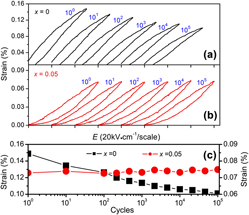Crossref Citations
This article has been cited by the following publications. This list is generated based on data provided by
Crossref.
Hao, Jigong
Xu, Zhijun
Chu, Ruiqing
Li, Wei
and
Du, Juan
2015.
Enhanced thermal stability and fatigue resistance in MTiO3-modified (K0.5Na0.5)0.94Li0.06NbO3 lead-free piezoelectric ceramics.
Journal of Materials Science: Materials in Electronics,
Vol. 26,
Issue. 10,
p.
7867.
Bahanurdin, Fatin Khairah
Mohamed, Julie Juliewatty
and
Ahmad, Zainal Arifin
2017.
Effect of Sintering Temperature on Structure and Dielectric Properties of Lead Free K<sub>0.5</sub>Na<sub>0.5</sub>NbO<sub>3</sub> Prepared via Hot Isostatic Pressing.
Materials Science Forum,
Vol. 888,
Issue. ,
p.
42.
Nishiyama, Hiroshi
Kakimoto, Ken-ichi
Hatano, Keiichi
and
Konishi, Yukihiro
2017.
High-power impedance spectroscopy for lead-free alkali niobate piezoceramics.
Japanese Journal of Applied Physics,
Vol. 56,
Issue. 10S,
p.
10PD07.
Yan, Xiao
Chen, Xiuli
Li, Xiaoxia
Liu, Gaofeng
Zhang, Hailin
and
Zhou, Huanfu
2018.
Good electrical performances and impedance analysis of (1 − x)KNN–xBMM lead-free ceramics.
Journal of Materials Science: Materials in Electronics,
Vol. 29,
Issue. 6,
p.
4538.
Hao, Jigong
Li, Wei
Zhai, Jiwei
and
Chen, Haydn
2019.
Progress in high-strain perovskite piezoelectric ceramics.
Materials Science and Engineering: R: Reports,
Vol. 135,
Issue. ,
p.
1.
Zhang, Yichi
and
Li, Jing-Feng
2019.
Review of chemical modification on potassium sodium niobate lead-free piezoelectrics.
Journal of Materials Chemistry C,
Vol. 7,
Issue. 15,
p.
4284.
2021.
Lead‐Free Piezoelectric Materials.
p.
33.
Praharaj, S.
Singha, A.
and
Rout, D.
2021.
Dielectric and piezoelectric properties of lead-free Na0.5Bi0.5TiO3-SrTiO3-BiFeO3 ternary system.
Journal of Alloys and Compounds,
Vol. 867,
Issue. ,
p.
159114.
Duong, Trang An
Nguyen, Hoang Thien Khoi
Lee, Sang-Sub
Ahn, Chang Won
Kim, Byeong Woo
Lee, Jae‒Shin
and
Han, Hyoung‒Su
2021.
Enhancement of electromechanical properties in lead‒free (1−x)K0.5Na0.5O3–xBaZrO3 piezoceramics.
JOURNAL OF SENSOR SCIENCE AND TECHNOLOGY,
Vol. 30,
Issue. 6,
p.
408.
Duong, Trang An
Ahn, Chang Won
Kim, Byeong Woo
Bafandeh, Mohammad Reza
Han, Hyoung-Su
and
Lee, Jae-Shin
2022.
Effects of SrTiO3 Modification on the Piezoelectric and Strain Properties of Lead-Free K0.5Na0.5NbO3-Based Ceramics.
Journal of Electronic Materials,
Vol. 51,
Issue. 4,
p.
1490.
Rana, Poonam
Gupta, Charanjeet
Chandel, Ashima
and
Shandilya, Mamta
2022.
Recent progress in piezoelectric properties of lead-free perovskite sodium potassium niobate.
Vol. 2458,
Issue. ,
p.
050006.
Zhang, Rui
Wang, Pengbin
Guo, Qinghu
Long, Jiale
Huang, Taixiang
Yao, Zhonghua
Cao, Minghe
Liu, Hanxing
and
Hao, Hua
2023.
High electric field-induced strain properties in La-doped Pb(In1/2Nb1/2)O3–PbZrO3–PbTiO3 relaxor ferroelectric ceramics.
Ceramics International,
Vol. 49,
Issue. 19,
p.
31582.
Liu, Chang
Li, Min
Zheng, Tianyang
Zhang, Tao
Lyu, Chongguang
Liu, Yunfei
and
Lyu, Yinong
2024.
Achieving giant field-induced strain in BS-modified BNKT lead-free ferroelectric ceramics.
Sensors and Actuators A: Physical,
Vol. 369,
Issue. ,
p.
115205.
Chen, Ran
Luo, Xinyi
Xing, Juanjuan
Zhang, Faqiang
Lu, Yiqing
Liu, Zhifu
and
Gu, Hui
2024.
Enhancing core–rim structure control in (K,Na)NbO3-based lead-free piezoceramics via rapid sintering method.
Journal of the European Ceramic Society,
Vol. 44,
Issue. 7,
p.
4612.
Yang, Zhenhai
Fan, Yongbo
Jia, Yuxin
Chen, Xinghong
Shang, Keyang
Tang, Shimiao
Fan, Huiqing
and
Wang, Weijia
2024.
Thermal and electromechanical performance in BaSnO3-modified potassium sodium niobate piezoceramics via two-step sintering.
Ceramics International,
Vol. 50,
Issue. 21,
p.
42237.
